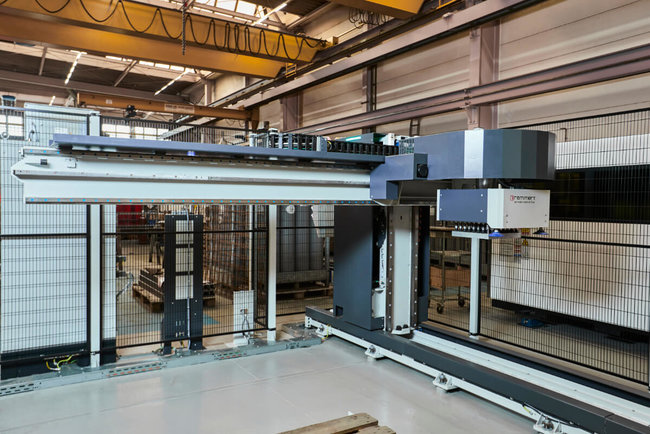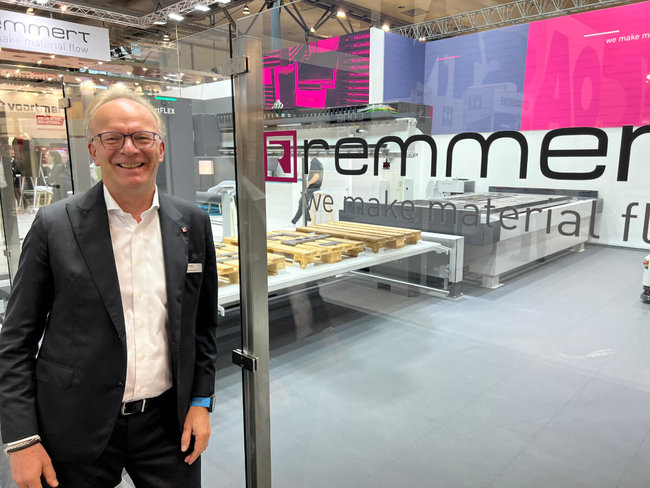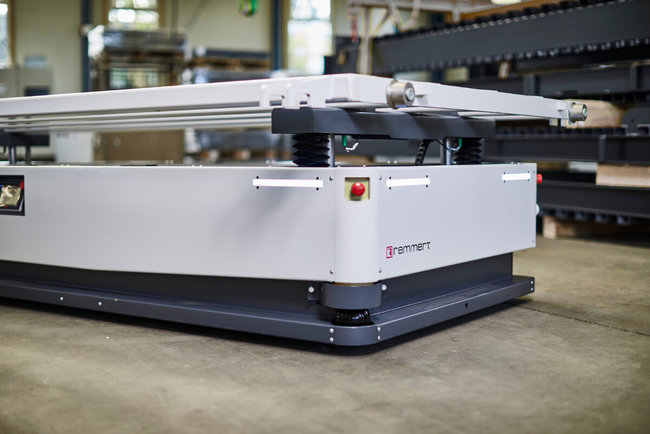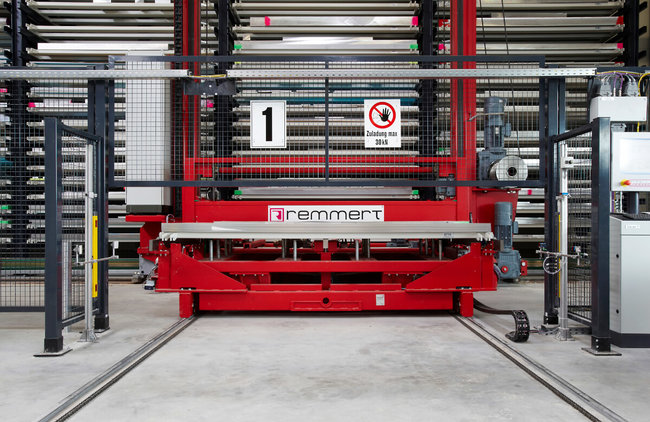For a long time, warehousing was almost frowned upon and was also classified as outdated. However, recent years have also clearly shown the downsides of globalization and the fragility of supply chains. It is therefore not surprising that many sheet metal processing companies are returning to more extensive stockholding in order to become more independent of supply chains and to be able to respond more flexibly to customer demand. The problem, however, is that manufacturing environments are often not designed for such a change in strategy, either due to a lack of space or more difficult process flows, as manufacturing is now often subject to different conditions that were not planned for. In addition, there is the ever-increasing shortage of skilled workers.
Exploiting the potential of the periphery
In times when production facilities are largely exhausted, the greatest potential for more economical production lies in the periphery. Stephan Remmert, Managing Director of Remmert GmbH, is well aware of the problem: "The supply chain issue affects us all. Plant manufacturers as well as parts producers.
In addition, there is enormous cost pressure on the manufacturing companies. The solution can therefore only be greater automation and networking of in tralogistics." The specialists for storage, automation and intralogistics for long goods and sheet metal can look back on more than 75 years of experience. Together with his brother Matthias, Stephan Remmert is now the third generation to run the family business and now employs around 160 people. "Especially when it comes to supply chain issues, many companies have learned to pull together. At Remmert, we see our suppliers as well as our customers as partners and have worked out a mutually acceptable solution together with them in difficult cases. We have done very well with this so far," says Stephan Remmert, looking back on the recent past.
Historically grown manufacturing
However, in order to be able to offer the optimal automation solutions, a great deal of flexibility is required from specialists like Remmert. "Most manufacturing operations have grown historically. Even if many companies are rethinking their warehousing and automation, it is usually not possible to completely reschedule production. The task here is to get the best out of the existing conditions. This is exactly our day-to-day business," explains Stephan Remmert. To this end, the company offers a comprehensive portfolio of solutions. In the sheet metal sector, for example, various tower storage systems, depending on the required size, storage and retrieval units, buffer loaders, loading and unloading systems, quick-change systems, transfer stations or even an AGV (automated guided vehicle). Specific special solutions are also realized.
Automate as needed
Remmert pursues a holistic intralogistics approach, from incoming goods to large-scale warehousing, internal transport, intermediate storage to the integration of individual systems or production islands and various production technologies, and relies on a modular design. "Our customers can pick out individual modules as required. These are always equipped with their own intelligence. This makes it possible to integrate our systems into the existing system regardless of the manufacturer. This means that they can be expanded or modified at any time. And that is important, because our storage and automation technology usually has a much longer service life than the production technology used. The product range in companies also changes more frequently. Thanks to our system, customers are able to continually adapt their existing automation to their needs without having to invest in completely new automation," says Stephan Remmert, explaining his philosophy. In this way, Remmert can react optimally to the existing structure, integrate its own solutions, or simply integrate existing systems quickly and easily into the intralogistics concept. "Often, only a small space requirement is taken into account when linking systems, and individual production islands are installed. The decisive factor, however, is to link different stand-alone solutions together in order to achieve an optimum level of automation. This is exactly where we come in," continues Stephan Remmert. In the process, the specialists also like to deviate from conventional approaches.
Bottleneck sorting
A good example of the potential that still lies in automation is the sorting of components, for example after laser cutting. Here, too, Remmert is taking a path that is not quite common, but very interesting. Remmert only presented new improvements for its Sort Flex palletizing robot at Euroblech 2022. "Sorting is not a trivial issue, because how easily parts can be absorbed is determined by many different factors in the process," explains Stephan Remmert. Many machine manufacturers have developed their own sorting systems for their machines, all of which can be integrated into Remmert's automation solutions on request.
Avoid standstill
However, Remmert is pursuing its own approach with its sorting solution. "It is important for us that the cutting systems are running and that there is no downtime for the systems due to sorting. Therefore, we do not sort directly at the shuttle table of the machine," explains Stephan Remmert. The sheets are therefore first transported from the machine to the sorting station. "We can sort around 90 percent of the typical parts spectrum automatically without any problems. But the question is, what do you do with the rest? If you were to operate manually directly at the system, the cutting system might have to wait. This is a delicate issue, especially when it comes to sorting, as there is hardly any system that can reliably guarantee a 100 percent quota here. Our system allows us to avoid this downtime by decoupling it from the cutting line. In addition, we are able to read in cutting plans from different manufacturers. Our software notifies the operator before sorting which parts cannot be sorted and where they are located. This means that they can be removed independently of the overall automated process, depending on requirements and capacity planning," says Stephan Remmert, outlining the process. This has the advantage that individual parts that cause problems during sorting do not stop the automated overall process.
Large AGV solution
However, in order to be able to respond optimally to the manufacturing environment, transport between the various manufacturing stations is an essential issue. An AGV is
an AGV is a natural choice in automated production. Here, too, the following applies: "We naturally integrate existing transport systems or, if required, also use a standard AGV solution.
standard AGV solution. However, this is not always the optimal solution. That is why we have developed our own AGV that is particularly well suited for transporting heavy and bulky goods," explains Stephan Remmert. The Remmert AGV has an unusually large transport platform of 3,000 x 1,200 mm and a payload of 3 tons. This makes it ideal for transporting sheet metal.
Also for cramped conditions
In order to be able to operate optimally even in confined production environments, Remmert opted for an omnidirectional solution. This means that the AGV can travel longitudinally, transversely or diagonally and can turn on the spot. This avoids space-consuming cornering and also makes it easy to approach transfer points. Such an AGV replaces forklifts and rigid conveyors. According to Remmert, the AGV can be equipped with various superstructures for load handling, such as a roller conveyor, drawing technology or a scissor lift table. Navigation takes place via sensors, so no complex guidance aids are required. The autonomous navigation technology (ANT) used is compatible with other compliant vehicles and will also conform to the future VDA 5050 directive. This ensures uniform fleet management of several AGV types. At the same time, the system is fully integrated into the in-house Smart Con-trol system, which also includes a warehouse management system. Remmert places particular emphasis here on maximum user-friendliness.
Intuitive process control
Stephan Remmert adds: "The process control must be just as comprehensible as the processes themselves. We started developing software differently a few years ago and placed a lot of emphasis on the human interface, because the processes have to be intuitively controllable. This is our top priority and we continue to work intensively on it. For our customers, intuitive usability is a key criterion when deciding on our products."



